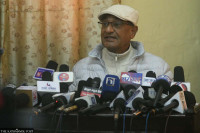National
Government move of forming a team to collect evidence on Nepal’s boundary runs into controversy
Experts and analysts say instead of devising a strategy for negotiations with New Delhi, Oli administration is moving a step back and putting the cart before the horse..jpg&w=900&height=601)
Anil Giri
Three weeks after releasing a new political and administrative map of Nepal depicting Kalapani, Lipulekh and Limpiyadhura as parts of the Nepali territory, the government on Wednesday formed a nine-member team of experts to collect historical facts and evidence related to the area.
Diplomats and experts, however, have questioned why the government formed the task force when the map has already been released and approved by the Cabinet. Even a constitutional amendment bill to update Nepal’s map in the national emblem is already in Parliament, which is set to endorse it on Saturday.
Acclaimed cartographer Buddhi Narayan Shrestha, who is also a former director general of the Department of Survey, wondered why the government was giving the mandate to a team of experts to collect historical facts and evidence when the map has already been released.
“We have enough documents and evidence to prove that the land currently occupied by India belongs to Nepal. If this expert team has been formed to collect evidence and proof about the disputed land, it is a wrong move,” Shrestha told the Post. “It’s actually one step back.”
Prime Minister KP Sharma Oli, Foreign Minister Pradeeep Gyawali and Minister for Land Management Padma Aryal had claimed that the new map was released based on historical facts and evidence that suggest the areas on the northwestern ridge belong to Nepal.
Accordingly, a constitutional amendment bill was registered in Parliament seeking to update the map in the national emblem. A proposal to consider the bill was unanimously endorsed by the House of Representatives on June 9.
“The move of forming a team to collect facts and evidence is like putting the cart before the horse,” Dinesh Bhattarai, a former ambassador, told the Post. “Formation of such a panel could weaken our position while negotiating with India.”
Even though the Oli government has upped the ante and ratcheted up its nationalist rhetoric, it has not ruled out talks with India to resolve the boundary row. With the government moving ahead to amend the constitution, India is also likely to harden its position.
“And Nepal setting up a team with the mandate of collecting facts and evidence may give India the upper hand during talks,” said Bhattarai. “India could ask why the Nepali side is looking for evidence after releasing the map.”
Even though India has claimed the disputed territories as its own, Nepal says it has enough evidence to prove that they belong to Nepal.
The government says until 1962, Nepal conducted census, collected land revenue and issued land registration certificates in the areas now controlled by India.
After the mandate ran into controversy, Foreign Minister Gyawali and Foreign Secretary Shanker Das Bairagi tried to clarify its objectives during the first meeting of the expert panel on Friday.
“The mandate given by the Cabinet to the team of experts and what Minister Gyawali briefed were contradictory,” a participant of the meeting told the Post on condition of anonymity. “There was a wrong briefing by Information and Communication Minister Yubraj Khatiwda on Thursday.”
According to the participant, both Gyawali and Bairagi said the core objective of the team is to provide support and inputs to the government for talks with India on boundary issues rather than collecting evidence and historical facts.
While making the Cabinet decision public on Thursday, Khatiwada did not say the mandate was to provide support to the government for talks to be held at the Foreign Secretary level.
The Cabinet decision, which the Post has seen, contains “formation of a team of experts to collect evidence in relation to the Nepal-India border”.
“This fiasco is the result of taking decisions in a hurry,” said another participant of the meeting. “The objective behind forming the team is to provide support to the government’s talk team, build antithesis and make grounds to defend Nepal's case during bilateral talks.”
Bishnu Raj Uprety, executive director of Policy Research Institute, a government-funded think tank, is the team coordinator; with Surya Prasad Subedi, a professor at the University of Leeds in the United Kingdom; Ramesh Dhungel, historian; Bipin Adhikari, senior advocate; Jagat Bhusal, water expert; Toyanath Baral, former director general of the Department of Survey; Himalaya Thapa, a retired Nepal Army general; and Apsara Chapagain, a community forestry activist, as members. Ram Prasad Subedi, a joint-secretary at the Ministry of Foreign Affairs, has been named the member-secretary.
According to the Cabinet decision, the team is mandated to find the original or attested copies of documents related to the Nepal-India border, including the evidence regarding the northwest boundary of Limpiyadhura, Kuti, Navi, Gunji, Kalapni and Lipulekh, and Susta in the Tarai.
The team is also mandated to collect evidence and documents from public entities, different organisations, persons and national and international libraries, according to the Cabinet decision.
The Uprety-led team is also tasked with collecting original or attested copies of the Nepal-India treaty, agreements and memoranda, and correspondence with the then East India Company and British and Indian governments as well as maps showing the Nepal-India border.
The team will also collect government reports, publications, government’s correspondence, administrative orders, court rulings and other records such as the receipts of land taxes and land ownership certificates.
The government so far has said the new map was published on the basis of the Treaty of Sugauli of 1816, which says the Kali river is the western boundary of Nepal and territories east of the river belong to Nepal.
On Tuesday, Minister Gyawali told Parliament that Nepal has enough evidence to claim its land currently occupied by India.
“As per the Treaty of Sugauli, the western border point is the origin of the Kali river,” said Gyawali. “After signing this treaty, in the last 60 years, we have noticed some changes in our southern border, but the source of the Kali river remains our western boundary point.”
Shrestha, the expert on boundary issues, said the government needs to devise a strategy on how to negotiate with India rather than forming a team of experts to collect evidence.
“It won’t give us the upper hand during talks with India,” said Shrestha. “Indians will definitely ask why we are looking for evidence and documents when a map has already been published.”
Bhattarai, the former ambassador, said the whole hubris over this issue is wrong.
“As the map has been released, such preparations should be carried out quietly and there is no need to make noise,” Bhattarai told the Post. “This whole exercise should have been part of the government’s internal homework.”




 8.12°C Kathmandu
8.12°C Kathmandu













%20(1).jpg&w=300&height=200)

